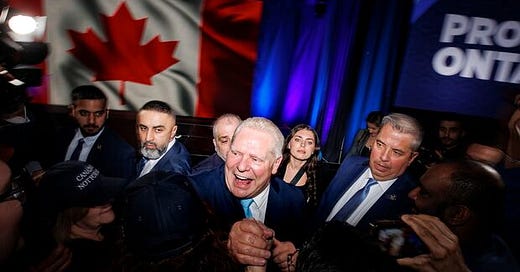Ontario’s Provincial Election Woes Present a Fresh Opportunity to Revisit Much-Needed Electoral Reform
With the incumbent PC’s securing less than 1 in 5 votes from Ontarians, here are the steps we can take to ensure that all Ontarians are represented in its government.
Premier Ford’s Progressive Conservatives have managed a rare “three-peat”, securing their third consecutive term in office – a feat not seen in Ontario since 1959.
How was this achieved? Despite some major ongoing scandals connected with the Greenbelt and Highway 413, as well as active crises in education, housing, and healthcare, a new majority PC government seems – on the surface – an unlikely result.
Officially, the PC’s secured 80 out of 124 eligible seats in the Ontario legislature, a dominant performance by any measure. But if you look more closely, you’ll note that out of 11 million registered voters, less than 1 in 5 Ontarians voted for Ford’s Progressive Conservatives (19.5%).
Image source: Fair Vote Canada
Also, you’ll notice that despite the Ontario Liberals receiving nearly double the number of votes as their NDP rivals, the party only secured half the number of seats in the Legislature.
To what do we owe these results?
An Outdated System That Drives Division
Ontario currently uses a “first-past-the-post” electoral system, a winner-take-all model that awards full representation to the party that secures the highest number of votes.
Even in the case where multiple parties secure a double-digit slice of the electorate, such as Toronto-St Paul’s, Ontario still follows a “winner-takes-all” model.
Graph source: Google Sheets
Ontario is a multicultural, diverse collection of communities totalling over 16 million people – all of which deserve fair representation. According to Statistics Canada, there are more than 15 major ethnic and cultural groups reported across the province – each with their own distinct beliefs, perspectives, and needs.
First-past-the-post voting not only fails to adequately represent Ontarians’ needs, but it actively weakens our democracy by disadvantaging minority voices, stifling competition, and worsening polarization. In fact, experts advise that winner-take-all electoral systems “are ill-advised for countries with deep ethnic, regional, religious, or other emotional and polarizing divisions.”
When asked how they would vote in the 2025 election, nearly a third of all Ontarians said they planned to vote strategically - voting not for personal preferences but for strategic reasons (e.g. to block a disliked candidate or party). According to Nik Nanos: “Strategic voters are more likely to be Liberals, New Democrats or Greens compared to PCs”. In other words, parties traditionally excluded by first-past-the-post systems often look to explore other ways to gain representation, such as strategic voting.
So how can we create a more effective electoral system?
Image source: Fair Vote Canada
The Benefits of Proportional Representation
Proportional representation is a form of voting that ensures political representation matches the share of votes a party receives. In other words, if a political party receives 40% of the vote, they should get 40% of the seats.
There are more than 130 countries globally who use either a proportional representation or mixed system when electing their representatives, including Austria, Denmark, Germany, Mexico, New Zealand, Norway, Portugal, South Korea, Switzerland. In fact, less than 55 countries use the “first-past-the-post” system, including the United Kingdom and – unfortunately – Canada.
Image source: IDEA International
Proportional representation not only leads to more effective political representation, but also better democratic institutions and greater human rights. In fact, 9 of the top 10 countries on the 2024 Human Freedom Index and Democracy Index 2023 use a proportional representation system.
Image source: Fair Vote Canada
The issue of electoral reform is not a new one, with debate raging back decades. In fact, two of Ontario’s four party leaders are fully in favour of proportional representation, including the Ontario Greens’ Mike Shreiner and Ontario NDP’s Marit Styles, with Ontario Liberals’ Bonnie Crombie also in favour of creating a citizens’ assembly on electoral reform.
A starting point would be to create a randomly-selected, diverse group of Ontarians to form a Citizens Assembly to rethink how we vote, which would provide non-partisan, binding recommendations for the government on how to modernize Ontario’s electoral system.
Ontario faces immense challenges in the months and years to come. In order to effectively address these challenges, we need effective representation from our diverse communities, and that starts with a rethink on electoral reform.










